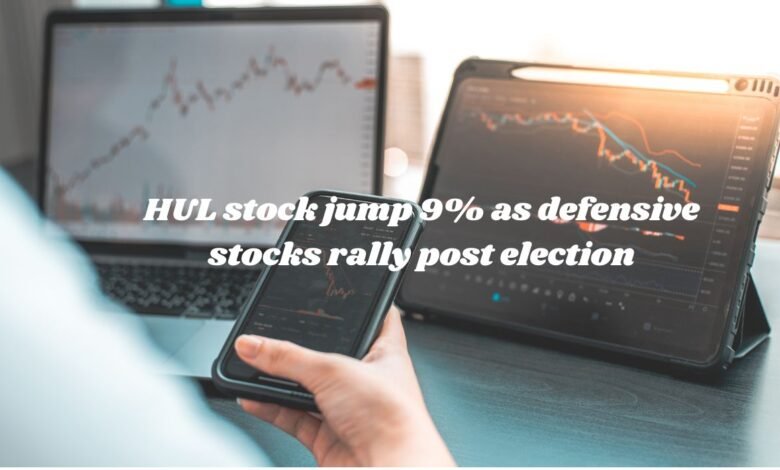HUL stock jump 9% as defensive stocks rally post election
HUL stock soars 9% as defensive stocks rally following the election, indicating investor confidence in stable, reliable investments.

Hindustan Unilever Limited (HUL) recently experienced a significant surge in its stock price, climbing by 9% in the aftermath of the national elections. This impressive increase in HUL stock comes amidst a broader trend where defensive stocks have generally rallied post-election. Defensive stocks, typically known for their stability and consistent dividends, often see increased investor interest during periods of uncertainty or political change.
HUL, a prominent player in the Fast-Moving Consumer Goods (FMCG) sector, holds a substantial market position with its extensive portfolio of well-known brands. This sector is often seen as a safe haven for investors due to its essential nature, which ensures steady demand regardless of economic conditions. The recent stock performance of HUL underscores its critical role within the FMCG industry and highlights investor confidence in the company’s resilience and growth potential.
The post-election environment has generally been favorable for defensive stocks, as investors tend to gravitate towards companies with robust fundamentals and lower volatility. HUL’s notable stock jump can be attributed to a combination of market dynamics and the company’s sound business strategies, which have consistently delivered strong financial results. As a leader in the FMCG sector, HUL’s stock performance is particularly noteworthy, reflecting its ability to navigate market fluctuations effectively.
This stock surge is not only a testament to HUL’s market strength but also a reflection of broader investor sentiment favoring defensive stocks in the current political and economic landscape. As we delve deeper into the factors contributing to this trend, it becomes evident that HUL’s strategic positioning and operational excellence play a crucial role in its stock market success. The recent election results have further amplified the appeal of such resilient companies, making HUL a prime example of how defensive stocks can thrive in a post-election scenario.
Understanding Defensive Stocks
Defensive stocks are a particular category of stocks known for their ability to provide consistent dividends and stable earnings, irrespective of the broader market’s performance. These stocks are typically associated with companies in industries that produce essential goods and services, such as utilities, healthcare, and consumer staples. The inherent stability of these sectors allows defensive stocks to maintain a relatively steady performance, even during economic downturns or periods of market volatility.
Investors often turn to defensive stocks during uncertain times, such as post-election periods, due to the perceived safety and reliability these stocks offer. The primary reasons for this investor behavior include:
- Steady Dividend Payments: Defensive stocks are known for their regular and reliable dividend payouts, providing a consistent income stream for investors.
- Stable Earnings: Companies behind defensive stocks tend to have stable earnings that are less affected by economic cycles, ensuring a more predictable financial performance.
- Lower Volatility: These stocks generally exhibit lower price volatility compared to other stock categories, making them less susceptible to sharp declines during market downturns.
- Essential Products and Services: Defensive stocks are often linked to industries that provide essential products and services, ensuring a continuous demand regardless of economic conditions.
Performance of defensive stocks to other stock categories during a recent market period:
| Stock Category | Performance (%) |
|---|---|
| Defensive Stocks | +9% |
| Growth Stocks | +4% |
| Cyclical Stocks | +2% |
| Tech Stocks | -3% |
As demonstrated in the table, defensive stocks delivered a notable performance (+9%) during the period, outpacing other stock categories, including growth stocks (+4%) and cyclical stocks (+2%), while tech stocks experienced a decline (-3%). This performance further underscores the appeal of defensive stocks as a safer investment during times of market uncertainty.
Factors Behind HUL’s Stock Rally
The sudden 9% surge in Hindustan Unilever Limited (HUL) stock post-election can be attributed to a constellation of factors, both macroeconomic and company-specific. Investors often seek refuge in defensive stocks during periods of uncertainty, and the recent election results have renewed investor confidence in stable, blue-chip companies like HUL. Here, we delve into the key elements contributing to this notable uptick.
Firstly, the election results have ushered in a wave of optimism among investors, heralding a period of anticipated stability and continuity in economic policies. This political landscape fosters a conducive environment for consumer goods companies, which are considered relatively safe investments during volatile times.
Secondly, HUL’s recent quarterly results have exceeded market expectations. The company reported robust revenue growth and higher profit margins, driven by strong domestic demand and effective cost management strategies. This financial performance has reinforced investor confidence, making HUL a more attractive option in the current market scenario.
Additionally, HUL has made several strategic decisions that have bolstered its market position. These include:
- Expanding its product portfolio to cater to evolving consumer preferences
- Increasing its focus on digital marketing and e-commerce channels
- Investing in sustainable practices and aligning with global sustainability goals
Market analysts have been largely optimistic about HUL’s future prospects. According to a report by Goldman Sachs, the company’s strong brand equity and extensive distribution network provide a competitive edge, particularly in rural markets where demand remains resilient.
Expert opinions also highlight the long-term benefits of HUL’s recent mergers and acquisitions. For instance, the integration of GlaxoSmithKline’s consumer healthcare business has expanded HUL’s footprint in the health and wellness sector, a segment witnessing rapid growth.
In conclusion, the 9% rally in HUL’s stock can be attributed to a blend of favorable election outcomes, stellar quarterly performance, and strategic initiatives that have collectively enhanced investor sentiment. The alignment of these factors has positioned HUL as a preferred choice for those seeking stability in a dynamic market environment.
What This Means for Investors
The recent 9% surge in HUL’s stock price following the post-election rally has significant implications for both current and potential investors. For those currently holding HUL shares, this price increase could be seen as a validation of their investment strategy. It reflects not only market confidence in HUL’s robust portfolio but also a broader trend favoring defensive stocks, particularly in the FMCG sector.
For potential investors, the current market conditions present a unique opportunity. HUL’s strong market position and consistent performance in the fast-moving consumer goods sector make it an attractive option. However, it’s crucial to consider the broader trends and potential risks. The FMCG sector has shown resilience, especially during economic uncertainties, which suggests that HUL is likely to maintain its upward trajectory in the near term.
Given the current market dynamics, the advice for investors would be nuanced. If you already hold HUL stocks, it might be wise to continue holding them. The recent price jump and the company’s strong fundamentals suggest that further appreciation is possible. On the other hand, if you are considering buying HUL stock, now might be a good time to invest, given the positive market sentiment and the company’s strong performance outlook. However, it is always essential to conduct thorough research and consider your risk tolerance before making any investment decision.
Key takeaways for investors:
| Action | Recommendation | Potential Risks | Potential Rewards |
|---|---|---|---|
| Current Holders | Hold | Market volatility, sector-specific risks | Further appreciation, dividend income |
| Potential Buyers | Buy | Overvaluation risk, market corrections | Long-term growth, strong market position |
| Potential Sellers | Consider holding | Missed future gains | Locking in current profits |
- This ‘gadgets’ list has divided government’s two key ministrie
- Eaton invests in Nordic data center power modules
- Breaking: India’s Q4 GDP at 7.8%, FY24 Growth Reaches 8.2%
Conclusion: HUL stock jump
HUL’s stock jump presents both opportunities and considerations for investors. Whether you decide to hold, buy, or sell, ensure your decision aligns with your overall investment strategy and risk appetite.
